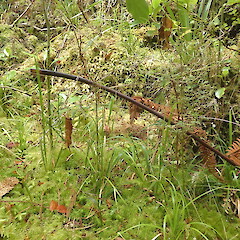Microlaena carsei
Synonyms
Microlaena avenacea var. carsei (Cheeseman) Zotov
Family
Poaceae
Flora category
Vascular – Native
Endemic taxon
Yes
Endemic genus
No
Endemic family
No
Structural class
Grasses
Chromosome number
2n = 48
Current conservation status
The conservation status of all known New Zealand vascular plant taxa at the rank of species and below were reassessed in 2017 using the New Zealand Threat Classification System (NZTCS) – more information about this can be found on the NZTCS website. This report includes a statistical summary and brief notes on changes since 2012 and replaces all previous NZTCS lists for vascular plants.
Please note, threat classifications are often suggested by authors when publications fall between NZTCS assessment periods – an interim threat classification status has not been assessed by the NZTCS panel.
- Conservation status of New Zealand indigenous vascular plants, 2017 . 2018. Peter J. de Lange, Jeremy R. Rolfe, John W. Barkla, Shannel P. Courtney, Paul D. Champion, Leon R. Perrie, Sarah M. Beadel, Kerry A. Ford, Ilse Breitwieser, Ines Schönberger, Rowan Hindmarsh-Walls, Peter B. Heenan and Kate Ladley. Department of Conservation. Source: NZTCS and licensed by DOC for reuse under the Creative Commons Attribution 4.0 International licence.
2017 | Threatened – Nationally Endangered | Qualifiers: DP, Sp
Previous conservation statuses
2012 | At Risk – Naturally Uncommon | Qualifiers: Sp
2009 | At Risk – Naturally Uncommon | Qualifiers: DP
2004 | Sparse
Distribution
Endemic. New Zealand: North Island (Te Paki south to Kerikeri and Waipoua, thence disjunct to Great Barrier Island (Aotea Island)).
Habitat
Seemingly endemic to kauri (Agathis australis (D.Don) Lindl)-dominated forest where it most usually found in damp, shaded hollows amongst tree roots and in shaded sites on the margins of fast flowing streams, and/or river banks. It is very easily overlooked.
Detailed description
Shortly creeping, rhizomatous, tufted, narrowly-leaved perennial grass. Rhizomes short, branching extravaginal, cataphylls 10-20 mm, bases swollen, glossy, keeled, acute. Internodes elongated, slender, glossy, glabrous, distinctly straminaceous, apel to dark brown. Leaf-sheath glabrous, keel stout, margin membranous. Ligule 0.75-1 mm, triangular. Auricles 2, marginal hairs 1.5–2.5 mm. Leaf-blade 80–250 × 4–8 mm, glaucous green to green, keel stout; margins sharp, prickle-edged. Culm up to 600 mm laterally compressed, internodes longitudinally grooved, glabrous. Panicle 200–300 mm, narrow, slender, nodes close-set, branches appressed, erect, filiform, nodes shortly branched with numerous close-set spikelets, often with longer, naked branches below; rachis longitudinally grooved, rachis, branches and pedicles finely prickled. Spikelets 15–23 mm, numerous, solitary, on short or long pedicels. Glumes unequal, covering base of spikelet, margins ciliate; lower 0.2–0.6 mm, 1-nerved, < callus hairs, upper 0.75–1.7 mm, 3-nerved, triangular acute or irregularly lobed to erose, > callus hairs. Lower sterile lemma 5–16 mm, 3–5-nerved, keel prickled edged and also above, otherwise smooth, undersides hairy, awn ½ lemma length, sometimes less than or equal lemma bearing perfect flowers, callus hairs 0.5 mm; upper sterile lemma 14–25 mm, 3–5-nerved, densely prickled-toothed on keels and above, smooth elsewhere, undersides hairy, awn ½ lemma length; callus hairs 1.5 mm, lemma bearing perfect flowers 5–10 mm, 3–5-nerved, awn 0–0.5 mm set between minute lobes, margins ciliate above, apex deeply bifid (0.4–0.8 mm), ciliate. Stamens 2; anthers 1–2.2 mm, yellow. Ovary 0.65–75 mm; stigma-styles 1–2.2. mm, nude below. Seed 3–4 mm.
Manaaki Whenua Online Interactive Key
Similar taxa
Microlaena avenacea (Raoul.) Hook.f. from which M. carsei differs by its shortly creeping rhizomatous habit, narrower leaves and panicles. The two species are sympatric throughout the known range of M. carsei.
Flowering
September–February
Flower colours
Yellow
Fruiting
October–May
Propagation technique
Easily grown from rooted pieces, from divisions of whole plants and from fresh seed. An attractive creeping, tufted grass that does best in partially shaded, moist soils.
Threats
Exact distribution is still unknown but most populations that are known about seem secure and are well portected within forest reserves. One population near Kerikeri is at risk from frequent flooding depositing silt on plants and also spreading weeds such as Tradescantia fluminensis Vell and Selaginella kraussiana (Kunze) A.Braun which are rapidly smothering this grass and other indigenous riparian species.
Etymology
microlaena: Small cover (outer scales of spikelet)
Where To Buy
Not commercially available
Attribution
Fact Sheet prepared for NZPCN by P.J. de Lange (1 November 2009). Description based on Edgar & Connor (2000). See also Cheeseman (1914).
References and further reading
Cheeseman TF. 1914 (1915). New Species of Flowering-plants. Transactions of the New Zealand Institute 47: 45–47. https://paperspast.natlib.govt.nz/periodicals/TPRSNZ1914-47.2.4.1.3
Edgar E, Connor HE. 2000. Flora of New Zealand. Vol. V. Grasses. Manaaki Whenua Press, Christchurch, NZ. 650 p.
NZPCN Fact Sheet citation
Please cite as: de Lange, P.J. (Year at time of access): Microlaena carsei Fact Sheet (content continuously updated). New Zealand Plant Conservation Network. https://www.nzpcn.org.nz/flora/species/microlaena-carsei/ (Date website was queried)








